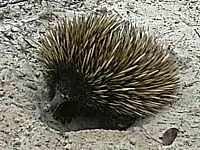Prototheria facts for kids
Quick facts for kids PrototheriaTemporal range: Upper Triassic – Recent
|
|
|---|---|
 |
|
| Short-beaked Echidna | |
| Scientific classification | |
| Kingdom: | |
| Phylum: | |
| Class: | |
| Subclass: |
Prototheria
Gill, 1872
|
| Orders | |
|
|
Prototheria was an old way to group certain mammals. Scientists don't use this grouping much anymore. The name comes from two ancient Greek words: prōtos, meaning 'first', and thēr, meaning 'beast'.
The only animals from this group that are still alive today are the Monotremes. These are unique mammals that lay eggs instead of giving birth to live young.
Scientists used to divide mammals into three main groups, or subclasses. Besides Prototheria, there were also the Metatheria and the Eutheria. The Metatheria group includes all the marsupials, like kangaroos and koalas. All other mammals, including humans, belong to the Eutheria group.
Today, scientists are learning more about how these animals are related. They are finding that Prototheria might not be a "natural group." This means the animals in it might not be as closely related as once thought. Scientists are still working to figure out the best way to group these amazing creatures.
Contents
What are Prototheria?
The term "Prototheria" was used to describe mammals that were thought to be very ancient. They were seen as the "first beasts" because of their unique features. These features include laying eggs, which is a trait shared with reptiles and birds.
Monotremes: Living Fossils
The most famous members of the Prototheria are the monotremes. These are the only mammals that lay eggs. There are only a few types of monotremes left in the world today.
- Echidnas: These spiny animals look a bit like porcupines. They live in Australia and New Guinea. They have a long snout and a sticky tongue to catch insects.
- Platypuses: The platypus is a very unusual animal from Australia. It has a duck-like bill, webbed feet, and a beaver-like tail. Male platypuses even have venomous spurs on their hind legs!
Monotremes are special because they show us how mammals might have evolved. They have a mix of traits from mammals, reptiles, and birds.
How Scientists Group Mammals
Scientists use different ways to group animals. This helps them understand how living things are related. They look at things like DNA, fossils, and body features.
Old Ways of Grouping
In the past, scientists grouped mammals based on how they reproduced.
- Prototheria: Mammals that lay eggs (like monotremes).
- Metatheria: Mammals that have a pouch for their young (like marsupials).
- Eutheria: Mammals that give birth to fully developed young (like most mammals).
New Discoveries
With new technology, scientists can now study DNA. This has changed how they group animals. DNA evidence shows that some animals once grouped together might not be as closely related as thought. This is why the term "Prototheria" is not used as much anymore. Scientists are always learning and updating their understanding of the animal kingdom.
Images for kids
See also
 In Spanish: Prototerios para niños
In Spanish: Prototerios para niños


